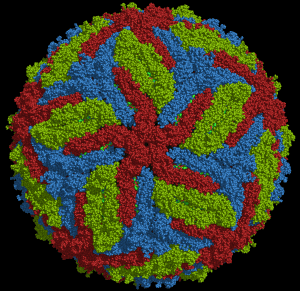

When a Samoan isolate of Zika virus was injected into the brain of embryonic day 13.5 mice, the virus replicated mainly in neural progenitor cells, but also in many other brain cells (link to paper). At 5 days after infection, brain size was markedly reduced compared with uninfected littermates. Infection of neural progenitor cells disrupted their normal differentiation program which leads to the production of mature neurons. Gene expression profiling of infected brains showed an increase in the production of cytokines, suggesting that these proteins might play a role in disease development. The expression of genes that have been previously associated with microcephaly was reduced. The authors conclude that “these effects are likely to account for microcephaly in human fetuses or newborn babies.”
In a different approach (link to paper), pregnant mice (not fetuses as in the previous study) were infected with a Brazilian Zika virus strain, and newborns were studied. Zika virus was detected in many tissues of newborns, especially in brain. Newborn mice displayed overall reduced growth, cortical malformations, and reduced cortical cell number and cortical layer thickness, all defects associated with microcephaly in humans. The infected mice also had ocular abnormalities similar to those that have been observed in babies with congenital Zika virus syndrome. Of note was the observation that the ability of Zika virus to cross the placenta was dependent on the strain of mouse used. I would not be surprised if the ability of viruses (or any microbe) to cross the human placenta is also determined in part by the genetics of the host.
The authors of this study suggest that human to human passage of Zika virus in humans for ~60 years led to a strain that can cross the placenta and infect the fetus. Consistent with their hypothesis, they show that replication of a Brazilian Zika virus strain in human brain organoids (three-dimensional models of the human brain produced from human pluripotent stem cells), greater morphological abnormalities and a reduction in size compared with effects cause by infection with an African strain of the virus. Furthermore, they find that a Brazilian Zika virus strain does not replicate in chimpanzee organoids, while the African strain does well. However, they do not address their hypothesis directly by determining in their mouse model whether an African strain of Zika virus can cross the placenta and infect the fetus.
A third report provides insight into how Zika virus might cross the placenta (paper link). This model consists of immunocompromised mice in which the type I interferon response has been ablated either genetically or by the administration of antibodies to the receptor for this cytokine. Pregnant mice are infected subcutaneously in the footpad with a French Polynesian Zika virus strain at embryonic days 6.5 and 7.5; embryos are then sacrificed 7 or 8 days later. No microcephaly was observed, but virus was detected in the head of the fetus. Replication was also detected in placenta and is accompanied by placental damage. Infected placentas are smaller, have damaged blood vessels, and display evidence of cell death and virus replication in various types of trophoblasts that make up placental tissues. In contrast, dengue virus did not replicate in the placenta or in the fetus.
These observations suggest that Zika virus can cross the placenta and move from the maternal blood into the fetus. The authors conclude that “The cellular and ultrastructural evidence of ZIKV infection in trophoblasts and fetal endothelium suggests that maternal viremia leads to compromise of the placental barrier by infecting fetal trophoblasts and entering the fetal circulation.
Previously it was shown that term placentas are resistant to Zika virus infection due to the production of type III interferon (paper link). The authors of the mouse study described above suggest that Zika virus may cross the placenta early in pregnancy due to infection of extravillous trophoblasts. These cells are abundant early but not later in pregnancy.
These three reports provide conclusive evidence that Zika virus can cross the placenta and cause fetal defects in mice, and provide models to understand the biology and pathogenesis of infection.
I am astounded at the unprecedented, rapid and frequent publication of new research results on Zika virus biology and pathogenesis. This phenomenon reflects the willingness and ability of large and mature groups of investigators from diverse fields (virology, neurobiology, cell biology) to tackle a new problem and make rapid progress.
I predict that we will learn more about Zika virus in the next year than we have about any other microbe in a similar period of time.

Comments are closed.